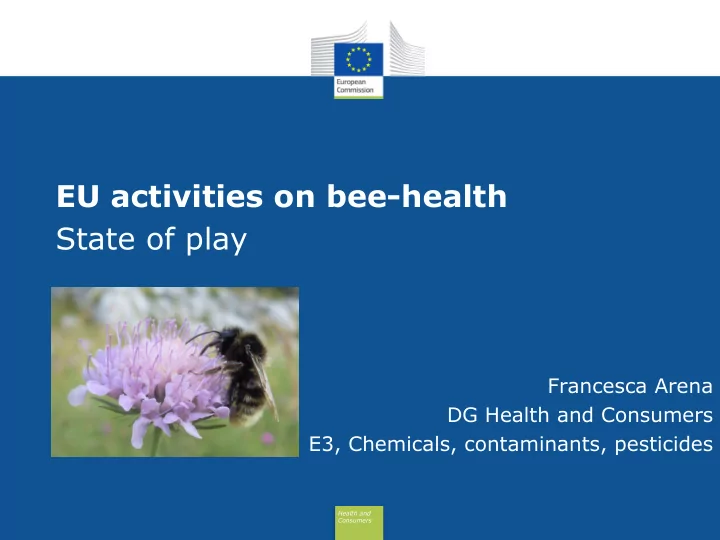

EU activities on bee-health State of play Francesca Arena DG Health and Consumers E3, Chemicals, contaminants, pesticides Health and Consumers
Content Commission policies on Bee Health 1 Strategy – Commission Communication 2 Pesticides 3 Animal health – EURL 4 Veterinary medicines 5 Agriculture 6 Research 7 Conclusions Health and Consumers
1. Strategy Commission Communication on honeybee health December 2010 COM (2010) 714 final Health and Consumers
1. Strategy Wide Commission inter-sevice group • DG SANCO • Animal health: pathogens • Pesticides • Veterinary medicines • Residues in honey • DG Agriculture • Honey production, apiculture programmes • Environmental measures • DG Environment • Biodiversity • DG Research • Animal health • Environmental • Other DGs … Health and Consumers
1. Strategy Commission Communication on honeybee health Bee health is linked with many factors of a different nature: • bacterial, viral, parasitic, etc • food availability • availability of appropriate treatments • invasive species • environmental changes • the use of pesticides in agriculture Health and Consumers
2. Pesticides Regulation (EC) No 1107/2009 placing of plant protection products on the market (fully applicable since June 2011) ü Strengthen existing criteria for approval of active substances è effects on honeybee larvae and colony development ü New data requirements for pesticides dossiers – Regulations (EU) No 283-284/2013 è (chronic effects of pesticides; real exposure of bees to pesticides e.g. nectar and pollen, guttation) Health and Consumers
2. Pesticides • 2011- COM mandate EFSA to Review the risk assessment scheme for bees • 2 steps approach: Step 1 - EFSA Opinion on the Science behind the risk assessment for bees (May 2012) Step 2 - Guidance document for the risk assessment for bees (July 2013) Health and Consumers
2. Pesticides 1/4 5 neonicotinoids (NNI) approved as plant protection products at EU level • Acetamiprid since 2004 • Thiacloprid since 2004 • Clothianidin since 2006 Higher acute • Thiamethoxam since 2007 toxicity profile 1 • Imidacloprid since 2008 1 : Statement EFSA Journal May 2012; 10(5): 2752 Health and Consumers
Review of 2. Pesticides 2/4 neonicotinoids COM requested EFSA to review neonicotinoids as regard their impact on bees (Art 21 Regulation (EC) No 1107/2009) Spring 2012 , following new scientific publications on the sub-lethal effects of neonicotinoids 3 NNI (Clothianidin, thiamethoxam and imidacloprid) seed treatment and granular applications 3 main routes of exposure for bees: - dust - residues in nectar and pollen - residues in guttation Health and Consumers
2. Pesticides 3/4 EFSA Conclusions published on 16 January 2013 Acute risks identified for all crops attractive to bees Several data gaps and need for further studies Some safe uses (e.g. sugar beet, green houses) Health and Consumers
Health and Consumers
2. Pesticides 4/4 Regulation (EU) No 485/2013 Significantly restrict the use of PPP and treated seeds containing the 3 substances (fully applicable from 1 December 2013) • The uses of PPP and treated seeds will remain available only to professional users for: • - crops not attractive to bees • - green-houses • - winter cereals • - post-flowering foliar application • COM will initiate review of the measure within 2 years Health and Consumers
2. Pesticides Fipronil Following the EFSA assessment of the Italian Apenet Project 2 nd Semester 2012, COM requested EFSA to review fipronil (phenyl-pyrazole) as regard its impact on bees (Art 21 Regulation (EC) No 1107/2009) • EFSA Conclusions published on 27 May 2013 • Regulation (EU) No 781/2013 significantly restrict the use of PPP and treated seeds containing fipronil (applicable from 1 March 2014) Health and Consumers
3. Animal health EU bee health reference laboratory • ANSES – Sophia-Antipolis lab in France • Expert meetings since 2011 • Role • Design and coordinate EU surveillance • Diagnostics • Technical and scientific assistance • Network of national reference labs Health and Consumers
3. Animal health EU bee health surveillance studies • Started in spring 2012 • € 3,3 million: EU financial contribution • 17 voluntary Member States (BE, DK, DE, EE, EL, ES, FR, IT, LT, LV, HU, PT, PL, SK, FI, SE, UK) • Harmonised protocol and check list • Three visits: autumn + spring + summer • Harmonised software and database • Recently prolonged until autumn 2014 • Results 2012-2013 soon available Health and Consumers
4. Veterinary medicines • Limited availability of medicines for bees • relatively small market for this type of product • difficult issue, little progress • Full review of veterinary medicines legislation is ongoing Health and Consumers
5. Agriculture Agriculture and rural development • Council Regulation (EC) 1234/2007 • Direct payments – Articles 107 to 109 • New national apiculture programmes in 2013 • New funds for 2014-2017 • Recent Commission report to Parliament and Council: COM (2013) 593 final Health and Consumers
Agriculture measures • Measure A: Technical assistance • Measure B: Varroasis Prevention • Measure C: Rationalisation of Transhumance • Measure D: Analyses of Honey • Measure E: Restocking of Hives • Measure F: Applied Research Health and Consumers
6.Research • A project (BEEDOC) finished recently • Interactions between factors affecting bee health: viruses, pesticides etc. • A project (STEP) until 2015 • Status of pollinators and mitigation • COLOSS (bee scientists networking) • finished end of 2012 • New project starts soon on sustainable apiculture • Focus on Varroa control without chemicals: breeding • Still many knowledge gaps on bees and wild pollinators Health and Consumers
7. Conclusions • An EU framework is in place to protect bee health • Measures based on science and data • Recent unprecedented measures on Neonicotinoids • Constant monitoring, update • No easy and/or quick risk management solutions Health and Consumers
Recommend
More recommend